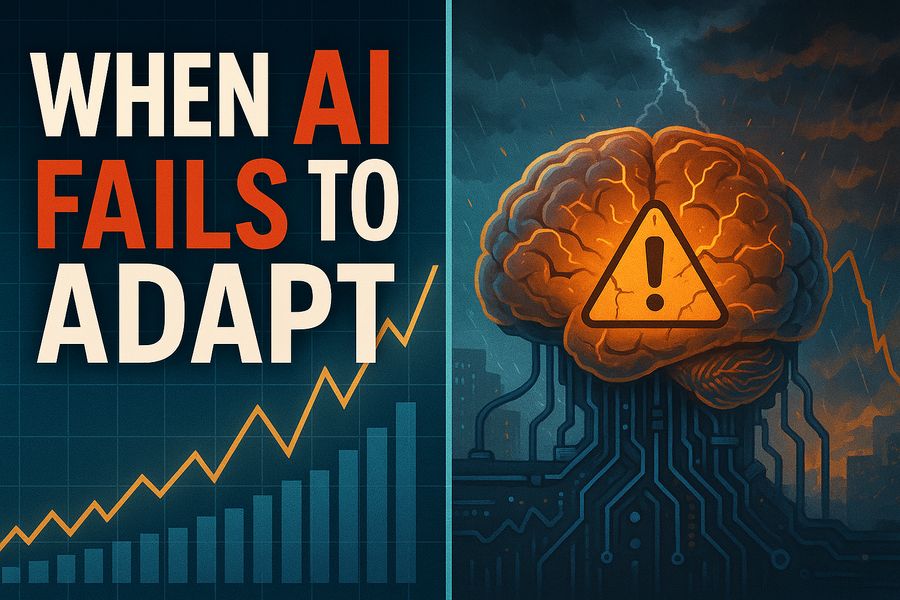Artificial Intelligence (AI) systems often boast impressive accuracy during testing, but what happens when the real world changes?
Many AI models are trained on historical data, which serves as a static snapshot of the world at a specific moment in time. While this can be effective short-term, it poses serious problems in dynamic environments — where behaviors, contexts, or distributions shift rapidly over time. This phenomenon reveals one of the most fundamental challenges in deploying AI in the real world: lack of adaptability. 🚧🧠
In this article, we’ll examine why AI struggles with change, the different types of data evolution, and solutions that can help build more resilient and future-ready systems.
📦 1. The Static Nature of Traditional AI Training
Training an AI model typically involves:
-
Collecting a large dataset 📚
-
Labeling and cleaning that dataset 🧹
-
Feeding it into a model that learns patterns 🔁
-
Validating its accuracy on a test set ✅
But there’s a catch: the model is fixed once it’s trained. It reflects the world as it was, not as it is — and definitely not as it will be. 🔒📉
Example:
An e-commerce recommendation model trained in 2021 may not reflect user trends, product popularity, or consumer behavior in 2025.
🌀 2. Types of Environmental Changes That Break AI
There are several ways in which AI models become obsolete due to environmental shifts:
🌪️ A. Data Drift
The statistical distribution of input data changes over time.
Example:
A medical diagnostic model trained on pre-pandemic symptoms may perform poorly when symptoms evolve (e.g., COVID variants).
🎯 B. Concept Drift
The relationship between inputs and outputs changes.
Example:
In fraud detection, tactics used by fraudsters constantly evolve, making old patterns irrelevant.
🕵️ C. Feature Relevance Shift
Certain features that were once important lose relevance or are no longer collected.
Example:
If a banking app removes or redefines “credit score” as a feature, models relying on it may mispredict risk.
⏱️ D. Temporal Validity
Some models are valid only for specific time frames or seasons.
Example:
Retail forecasting models trained on Black Friday data can’t predict January behavior accurately without adaptation.
🔬 3. Real-World Examples of AI Failure in Changing Environments
📉 Stock Market Prediction
Models trained on historical financial data often fail during sudden crashes or regulatory changes.
🤖 Chatbots and Language Models
AI trained on outdated slang or cultural references may fail to understand or respond appropriately to current trends.
🚘 Autonomous Vehicles
Driving policies and road behaviors vary between regions and over time. Static AI trained in one environment may not generalize.
🔍 4. Why Retraining Isn’t Always Enough
While retraining a model sounds like an easy fix, it introduces its own set of problems:
-
High cost: Data collection and model tuning are expensive 💰
-
Time-consuming: Retraining can take days or weeks ⏳
-
Version management: Risks of overwriting or misaligning models 🗂️
-
Drift detection: Knowing when to retrain is non-trivial 🔍
Without automatic systems to detect and react to change, retraining alone is not a sustainable solution.
✅ 5. Solutions to Combat Change and Build Adaptive AI
To overcome the challenge of a changing world, AI engineers are turning to smarter, more resilient techniques:
🔁 A. Online Learning
Instead of training once, online learning allows models to continuously update as new data arrives.
🔧 Example: A news recommendation engine that learns user preferences daily instead of yearly.
🔍 B. Drift Detection Algorithms
Special tools monitor incoming data and flag when drift occurs.
🔎 Tools like:
-
Kolmogorov–Smirnov test
-
Population Stability Index (PSI)
-
ADWIN (Adaptive Windowing)
These help identify when retraining is necessary.
☁️ C. Federated Learning
In decentralized settings, federated learning trains models at the edge (e.g., on phones), updating global models without centralizing data.
🌐 This allows real-time adaptation across diverse environments.
🛡️ D. Ensemble Methods
Combining multiple models trained on different time frames or distributions can make predictions more robust.
🧠 Some ensembles give higher weight to more recent models to stay current.
⚖️ E. Regular Monitoring and Human Oversight
No AI should be deployed without constant evaluation. Key metrics to monitor include:
-
Accuracy decay 📉
-
Confidence score shifts 📊
-
Real-world feedback loops 🔁
Human oversight remains crucial to ensure the AI aligns with ethical and societal expectations.
🔮 6. The Future of Adaptive AI
As AI continues to power dynamic industries like healthcare, finance, e-commerce, and transportation, adaptability will become a core feature of model design.
Emerging trends include:
-
Self-healing models that retrain themselves
-
Meta-learning — learning to learn from small data shifts
-
Explainable AI that signals when it’s uncertain or outdated
-
Synthetic data generation to simulate future conditions
🚀 The goal is to move from static intelligence to dynamic understanding — AI that evolves just like the world around it.
🏁 Final Thoughts
AI trained on past data can only be as effective as its relevance to the present. In a world that constantly changes — economically, culturally, and behaviorally — static models are bound to fail.
✅ The future of AI requires:
-
Continuous learning
-
Real-time monitoring
-
Ethical adaptation
-
Built-in flexibility
By recognizing and designing for change, we can build AI systems that not only perform well but remain trustworthy, resilient, and impactful in the long term. 🌟🧠


